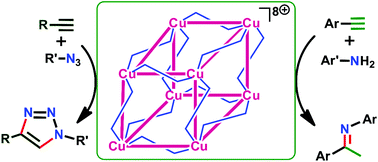Large Cu I8 chalcogenone cubic cages with non-interacting counter ions†
Abstract
Two mega size copper(I) cubic cages, [{Cu(Bptp)1.5}8(PF6−)](PF6−)7 (1) and [{Cu(Bpsp)1.5}8(PF6−)](PF6−)7 (2), supported by imidazole-2-chalcogenone ligands (Bptp = 2,6-bis(1-isopropylimidazole-2-thione)pyridine and Bpsp = 2,6-bis(1-isopropylimidazole-2-selone)pyridine) have been synthesized and characterized. The formation of ionic salts 1 and 2 was confirmed by FT-IR, multinuclear (1H, 13C, 31P and 19F) NMR, UV-vis, TGA, CHN analysis, BET analysis, single crystal X-ray diffraction and powder X-ray diffraction techniques. To the best of our knowledge, these are the first examples of a octanuclear copper(I) cluster in a perfect cubic architecture with a copper–copper distance of 8.413 Å or 8.593 Å. Interestingly, these anion-centered CuI8 cubic arrangements are not supported by cubic centered ions or face centered molecules. The formation of cationic cubic cages was accompanied by the association of twelve ligands (Bptp or Bpsp) with eight trigonal planar [CuSe3] vertices. The cationic charge of cubic cages was satisfied by eight PF6− counter anions, in which one of the PF6− anions occupies the centre of the Cu8 cube without any interaction. The copper(I) cubic cages are found to be highly active catalysts in click chemistry as well as hydroamination reactions. The scope of the catalytic reactions has been investigated with thirty-five different combinations of click reactions and six different combinations of the hydroamination of alkynes.



 Please wait while we load your content...
Please wait while we load your content...